Evaluating Financial Health: Cash Cycle, Risks, and Project Viability
VerifiedAdded on 2023/04/04
|6
|1140
|437
Report
AI Summary
This report provides a financial analysis, beginning with an examination of the cash conversion cycle, revealing a negative cycle indicating efficient working capital management. It identifies systematic market risk, technological risk, supply chain risk, foreign exchange fluctuation risk, and interest rate risk. The analysis includes an assessment of a share's performance against market indices, noting an increase in company debt. Bond valuation calculations are performed with and without interest payments. Furthermore, the report evaluates a project using Net Present Value (NPV) analysis, concluding that the project should be undertaken based on its positive NPV and an Internal Rate of Return (IRR) of 8%, which exceeds the cost of capital. The free cash flow calculations supporting the NPV analysis are appended to the report. Desklib offers similar solved assignments and study tools for students.
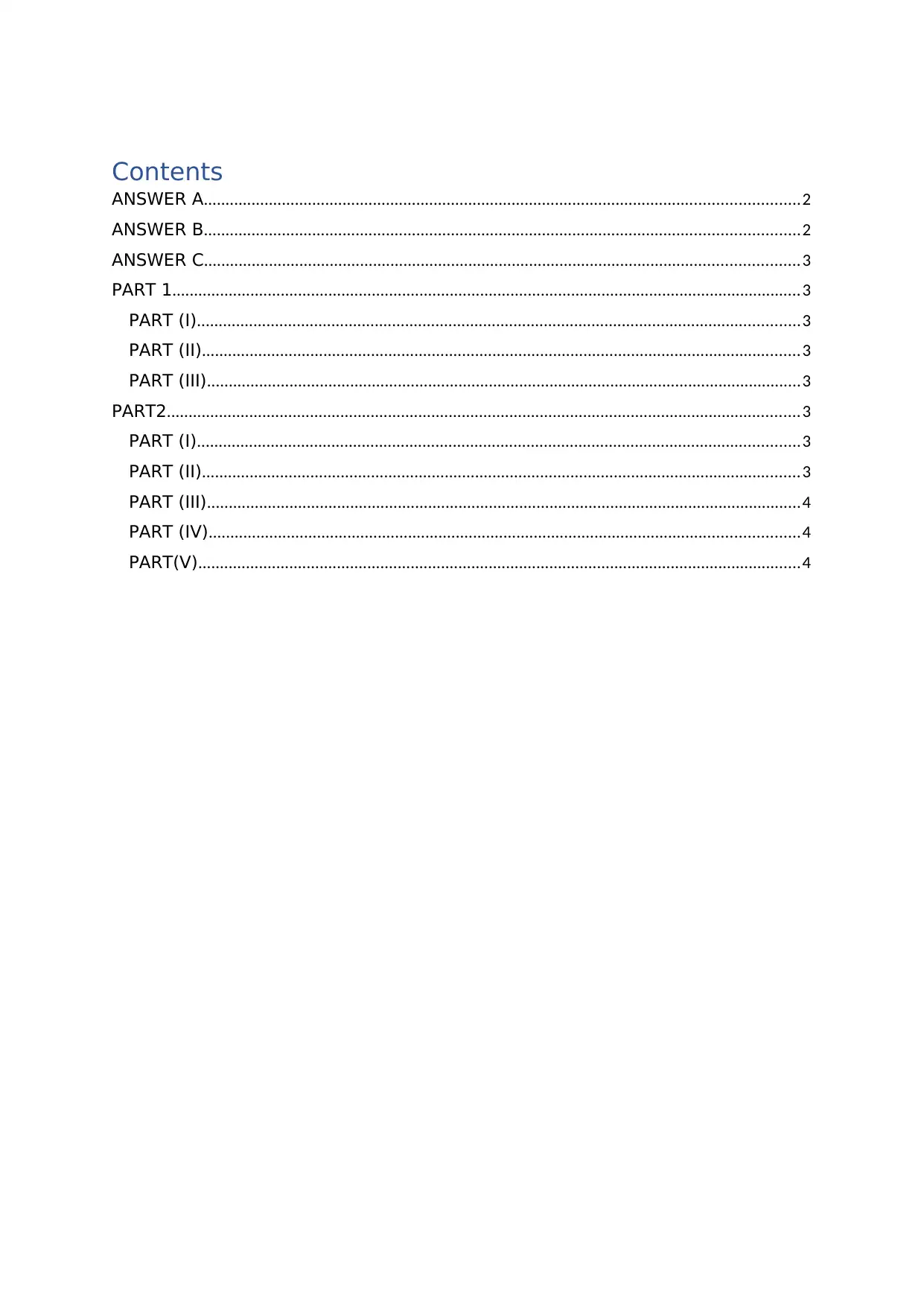
Contents
ANSWER A.........................................................................................................................................2
ANSWER B.........................................................................................................................................2
ANSWER C.........................................................................................................................................3
PART 1.................................................................................................................................................3
PART (I)...........................................................................................................................................3
PART (II)..........................................................................................................................................3
PART (III).........................................................................................................................................3
PART2..................................................................................................................................................3
PART (I)...........................................................................................................................................3
PART (II)..........................................................................................................................................3
PART (III).........................................................................................................................................4
PART (IV)........................................................................................................................................4
PART(V)...........................................................................................................................................4
ANSWER A.........................................................................................................................................2
ANSWER B.........................................................................................................................................2
ANSWER C.........................................................................................................................................3
PART 1.................................................................................................................................................3
PART (I)...........................................................................................................................................3
PART (II)..........................................................................................................................................3
PART (III).........................................................................................................................................3
PART2..................................................................................................................................................3
PART (I)...........................................................................................................................................3
PART (II)..........................................................................................................................................3
PART (III).........................................................................................................................................4
PART (IV)........................................................................................................................................4
PART(V)...........................................................................................................................................4
Paraphrase This Document
Need a fresh take? Get an instant paraphrase of this document with our AI Paraphraser
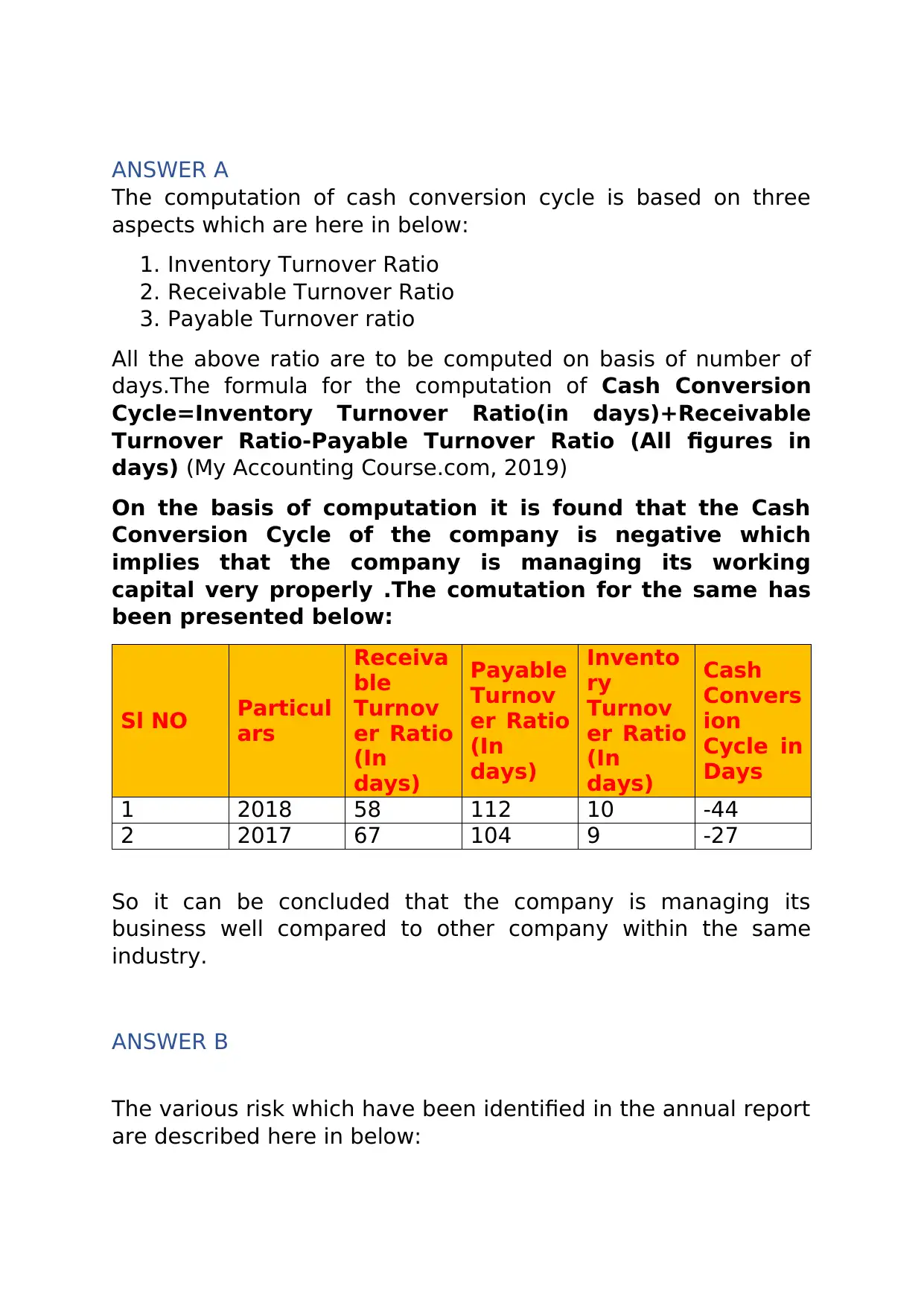
ANSWER A
The computation of cash conversion cycle is based on three
aspects which are here in below:
1. Inventory Turnover Ratio
2. Receivable Turnover Ratio
3. Payable Turnover ratio
All the above ratio are to be computed on basis of number of
days.The formula for the computation of Cash Conversion
Cycle=Inventory Turnover Ratio(in days)+Receivable
Turnover Ratio-Payable Turnover Ratio (All figures in
days) (My Accounting Course.com, 2019)
On the basis of computation it is found that the Cash
Conversion Cycle of the company is negative which
implies that the company is managing its working
capital very properly .The comutation for the same has
been presented below:
Sl NO Particul
ars
Receiva
ble
Turnov
er Ratio
(In
days)
Payable
Turnov
er Ratio
(In
days)
Invento
ry
Turnov
er Ratio
(In
days)
Cash
Convers
ion
Cycle in
Days
1 2018 58 112 10 -44
2 2017 67 104 9 -27
So it can be concluded that the company is managing its
business well compared to other company within the same
industry.
ANSWER B
The various risk which have been identified in the annual report
are described here in below:
The computation of cash conversion cycle is based on three
aspects which are here in below:
1. Inventory Turnover Ratio
2. Receivable Turnover Ratio
3. Payable Turnover ratio
All the above ratio are to be computed on basis of number of
days.The formula for the computation of Cash Conversion
Cycle=Inventory Turnover Ratio(in days)+Receivable
Turnover Ratio-Payable Turnover Ratio (All figures in
days) (My Accounting Course.com, 2019)
On the basis of computation it is found that the Cash
Conversion Cycle of the company is negative which
implies that the company is managing its working
capital very properly .The comutation for the same has
been presented below:
Sl NO Particul
ars
Receiva
ble
Turnov
er Ratio
(In
days)
Payable
Turnov
er Ratio
(In
days)
Invento
ry
Turnov
er Ratio
(In
days)
Cash
Convers
ion
Cycle in
Days
1 2018 58 112 10 -44
2 2017 67 104 9 -27
So it can be concluded that the company is managing its
business well compared to other company within the same
industry.
ANSWER B
The various risk which have been identified in the annual report
are described here in below:
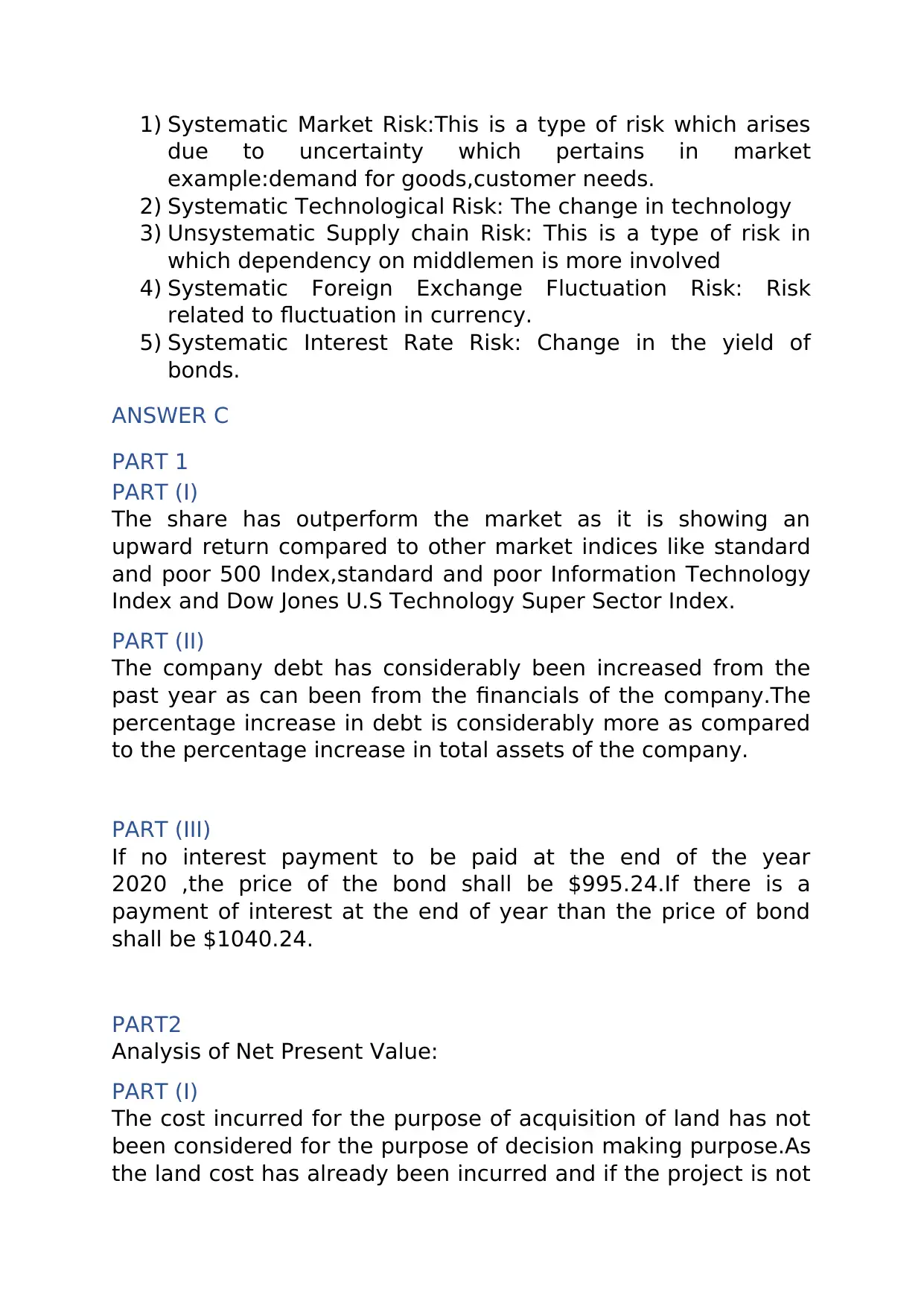
1) Systematic Market Risk:This is a type of risk which arises
due to uncertainty which pertains in market
example:demand for goods,customer needs.
2) Systematic Technological Risk: The change in technology
3) Unsystematic Supply chain Risk: This is a type of risk in
which dependency on middlemen is more involved
4) Systematic Foreign Exchange Fluctuation Risk: Risk
related to fluctuation in currency.
5) Systematic Interest Rate Risk: Change in the yield of
bonds.
ANSWER C
PART 1
PART (I)
The share has outperform the market as it is showing an
upward return compared to other market indices like standard
and poor 500 Index,standard and poor Information Technology
Index and Dow Jones U.S Technology Super Sector Index.
PART (II)
The company debt has considerably been increased from the
past year as can been from the financials of the company.The
percentage increase in debt is considerably more as compared
to the percentage increase in total assets of the company.
PART (III)
If no interest payment to be paid at the end of the year
2020 ,the price of the bond shall be $995.24.If there is a
payment of interest at the end of year than the price of bond
shall be $1040.24.
PART2
Analysis of Net Present Value:
PART (I)
The cost incurred for the purpose of acquisition of land has not
been considered for the purpose of decision making purpose.As
the land cost has already been incurred and if the project is not
due to uncertainty which pertains in market
example:demand for goods,customer needs.
2) Systematic Technological Risk: The change in technology
3) Unsystematic Supply chain Risk: This is a type of risk in
which dependency on middlemen is more involved
4) Systematic Foreign Exchange Fluctuation Risk: Risk
related to fluctuation in currency.
5) Systematic Interest Rate Risk: Change in the yield of
bonds.
ANSWER C
PART 1
PART (I)
The share has outperform the market as it is showing an
upward return compared to other market indices like standard
and poor 500 Index,standard and poor Information Technology
Index and Dow Jones U.S Technology Super Sector Index.
PART (II)
The company debt has considerably been increased from the
past year as can been from the financials of the company.The
percentage increase in debt is considerably more as compared
to the percentage increase in total assets of the company.
PART (III)
If no interest payment to be paid at the end of the year
2020 ,the price of the bond shall be $995.24.If there is a
payment of interest at the end of year than the price of bond
shall be $1040.24.
PART2
Analysis of Net Present Value:
PART (I)
The cost incurred for the purpose of acquisition of land has not
been considered for the purpose of decision making purpose.As
the land cost has already been incurred and if the project is not
⊘ This is a preview!⊘
Do you want full access?
Subscribe today to unlock all pages.

Trusted by 1+ million students worldwide
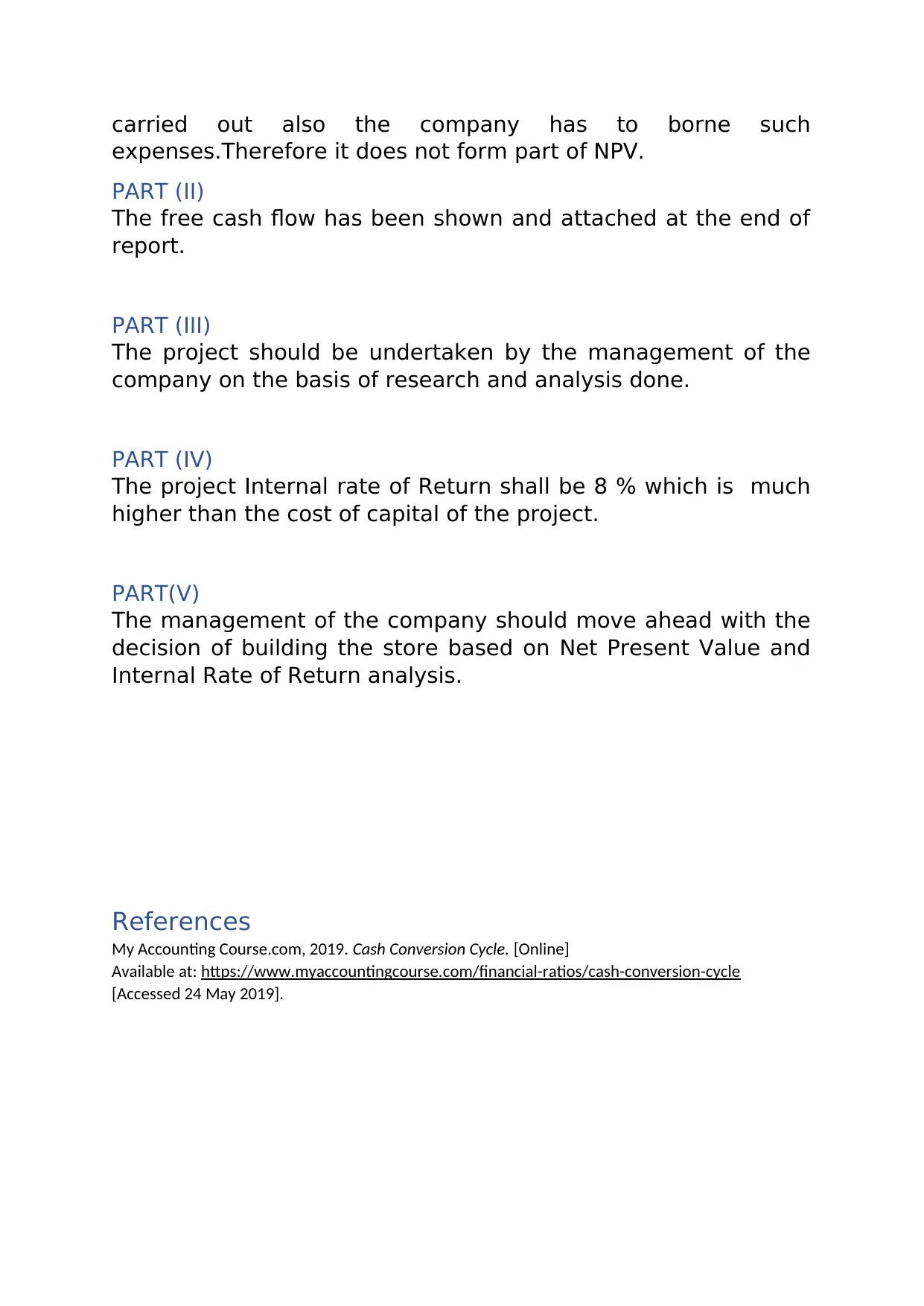
carried out also the company has to borne such
expenses.Therefore it does not form part of NPV.
PART (II)
The free cash flow has been shown and attached at the end of
report.
PART (III)
The project should be undertaken by the management of the
company on the basis of research and analysis done.
PART (IV)
The project Internal rate of Return shall be 8 % which is much
higher than the cost of capital of the project.
PART(V)
The management of the company should move ahead with the
decision of building the store based on Net Present Value and
Internal Rate of Return analysis.
References
My Accounting Course.com, 2019. Cash Conversion Cycle. [Online]
Available at: https://www.myaccountingcourse.com/financial-ratios/cash-conversion-cycle
[Accessed 24 May 2019].
expenses.Therefore it does not form part of NPV.
PART (II)
The free cash flow has been shown and attached at the end of
report.
PART (III)
The project should be undertaken by the management of the
company on the basis of research and analysis done.
PART (IV)
The project Internal rate of Return shall be 8 % which is much
higher than the cost of capital of the project.
PART(V)
The management of the company should move ahead with the
decision of building the store based on Net Present Value and
Internal Rate of Return analysis.
References
My Accounting Course.com, 2019. Cash Conversion Cycle. [Online]
Available at: https://www.myaccountingcourse.com/financial-ratios/cash-conversion-cycle
[Accessed 24 May 2019].
Paraphrase This Document
Need a fresh take? Get an instant paraphrase of this document with our AI Paraphraser
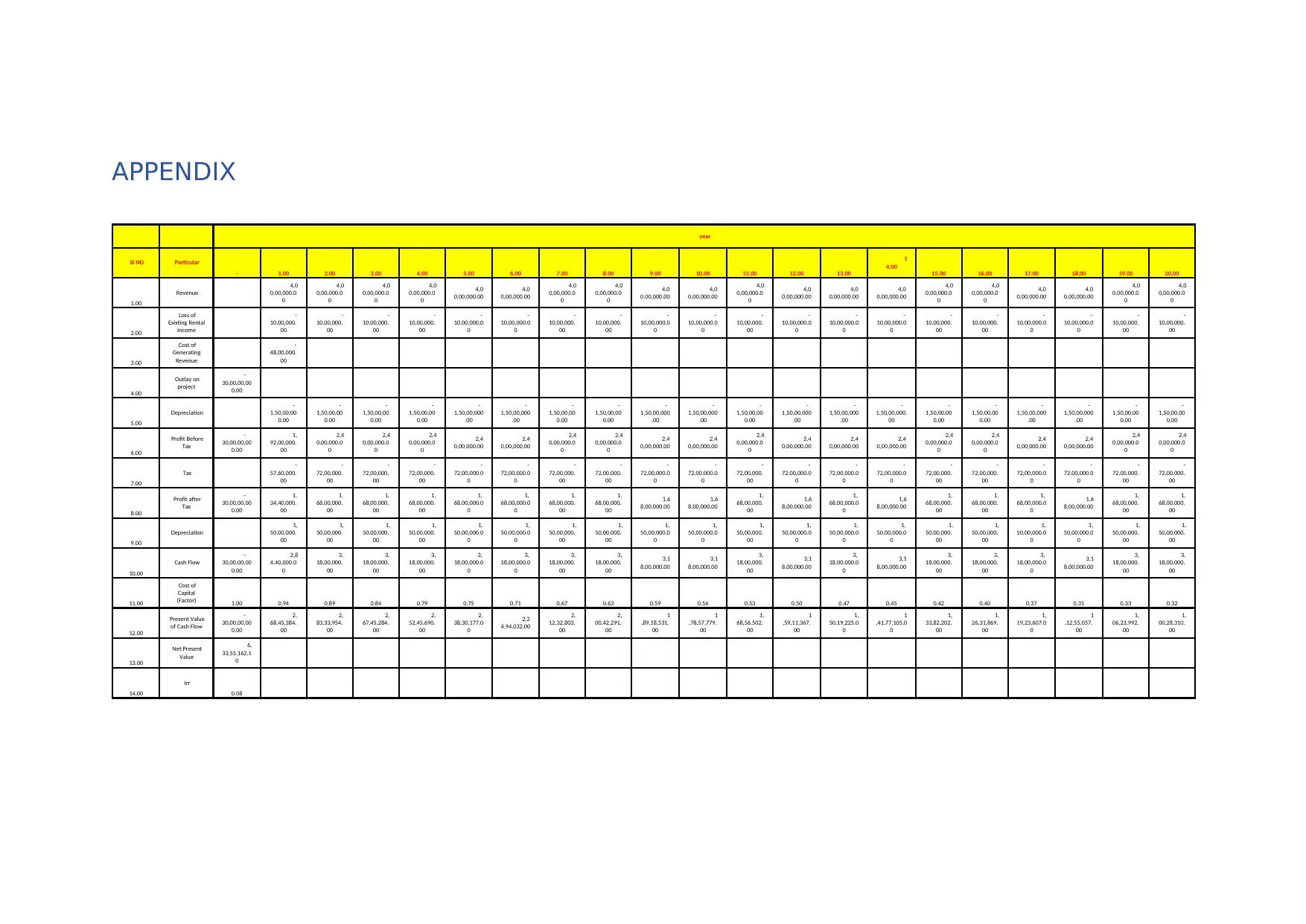
APPENDIX
year
Sl NO Particular
- 1.00 2.00 3.00 4.00 5.00 6.00 7.00 8.00 9.00 10.00 11.00 12.00 13.00
1
4.00
15.00 16.00 17.00 18.00 19.00 20.00
1.00
Revenue
4,0
0,00,000.0
0
4,0
0,00,000.0
0
4,0
0,00,000.0
0
4,0
0,00,000.0
0
4,0
0,00,000.00
4,0
0,00,000.00
4,0
0,00,000.0
0
4,0
0,00,000.0
0
4,0
0,00,000.00
4,0
0,00,000.00
4,0
0,00,000.0
0
4,0
0,00,000.00
4,0
0,00,000.00
4,0
0,00,000.00
4,0
0,00,000.0
0
4,0
0,00,000.0
0
4,0
0,00,000.00
4,0
0,00,000.00
4,0
0,00,000.0
0
4,0
0,00,000.0
0
2.00
Loss of
Existing Rental
Income
-
10,00,000.
00
-
10,00,000.
00
-
10,00,000.
00
-
10,00,000.
00
-
10,00,000.0
0
-
10,00,000.0
0
-
10,00,000.
00
-
10,00,000.
00
-
10,00,000.0
0
-
10,00,000.0
0
-
10,00,000.
00
-
10,00,000.0
0
-
10,00,000.0
0
-
10,00,000.0
0
-
10,00,000.
00
-
10,00,000.
00
-
10,00,000.0
0
-
10,00,000.0
0
-
10,00,000.
00
-
10,00,000.
00
3.00
Cost of
Generating
Revenue
-
48,00,000.
00
4.00
Outlay on
project
-
30,00,00,00
0.00
5.00
Depreciation
-
1,50,00,00
0.00
-
1,50,00,00
0.00
-
1,50,00,00
0.00
-
1,50,00,00
0.00
-
1,50,00,000
.00
-
1,50,00,000
.00
-
1,50,00,00
0.00
-
1,50,00,00
0.00
-
1,50,00,000
.00
-
1,50,00,000
.00
-
1,50,00,00
0.00
-
1,50,00,000
.00
-
1,50,00,000
.00
-
1,50,00,000.
00
-
1,50,00,00
0.00
-
1,50,00,00
0.00
-
1,50,00,000
.00
-
1,50,00,000
.00
-
1,50,00,00
0.00
-
1,50,00,00
0.00
6.00
Profit Before
Tax
-
30,00,00,00
0.00
1,
92,00,000.
00
2,4
0,00,000.0
0
2,4
0,00,000.0
0
2,4
0,00,000.0
0
2,4
0,00,000.00
2,4
0,00,000.00
2,4
0,00,000.0
0
2,4
0,00,000.0
0
2,4
0,00,000.00
2,4
0,00,000.00
2,4
0,00,000.0
0
2,4
0,00,000.00
2,4
0,00,000.00
2,4
0,00,000.00
2,4
0,00,000.0
0
2,4
0,00,000.0
0
2,4
0,00,000.00
2,4
0,00,000.00
2,4
0,00,000.0
0
2,4
0,00,000.0
0
7.00
Tax
-
57,60,000.
00
-
72,00,000.
00
-
72,00,000.
00
-
72,00,000.
00
-
72,00,000.0
0
-
72,00,000.0
0
-
72,00,000.
00
-
72,00,000.
00
-
72,00,000.0
0
-
72,00,000.0
0
-
72,00,000.
00
-
72,00,000.0
0
-
72,00,000.0
0
-
72,00,000.0
0
-
72,00,000.
00
-
72,00,000.
00
-
72,00,000.0
0
-
72,00,000.0
0
-
72,00,000.
00
-
72,00,000.
00
8.00
Profit after
Tax
-
30,00,00,00
0.00
1,
34,40,000.
00
1,
68,00,000.
00
1,
68,00,000.
00
1,
68,00,000.
00
1,
68,00,000.0
0
1,
68,00,000.0
0
1,
68,00,000.
00
1,
68,00,000.
00
1,6
8,00,000.00
1,6
8,00,000.00
1,
68,00,000.
00
1,6
8,00,000.00
1,
68,00,000.0
0
1,6
8,00,000.00
1,
68,00,000.
00
1,
68,00,000.
00
1,
68,00,000.0
0
1,6
8,00,000.00
1,
68,00,000.
00
1,
68,00,000.
00
9.00
Depreciation
1,
50,00,000.
00
1,
50,00,000.
00
1,
50,00,000.
00
1,
50,00,000.
00
1,
50,00,000.0
0
1,
50,00,000.0
0
1,
50,00,000.
00
1,
50,00,000.
00
1,
50,00,000.0
0
1,
50,00,000.0
0
1,
50,00,000.
00
1,
50,00,000.0
0
1,
50,00,000.0
0
1,
50,00,000.0
0
1,
50,00,000.
00
1,
50,00,000.
00
1,
50,00,000.0
0
1,
50,00,000.0
0
1,
50,00,000.
00
1,
50,00,000.
00
10.00
Cash Flow
-
30,00,00,00
0.00
2,8
4,40,000.0
0
3,
18,00,000.
00
3,
18,00,000.
00
3,
18,00,000.
00
3,
18,00,000.0
0
3,
18,00,000.0
0
3,
18,00,000.
00
3,
18,00,000.
00
3,1
8,00,000.00
3,1
8,00,000.00
3,
18,00,000.
00
3,1
8,00,000.00
3,
18,00,000.0
0
3,1
8,00,000.00
3,
18,00,000.
00
3,
18,00,000.
00
3,
18,00,000.0
0
3,1
8,00,000.00
3,
18,00,000.
00
3,
18,00,000.
00
11.00
Cost of
Capital
(Factor) 1.00 0.94 0.89 0.84 0.79 0.75 0.71 0.67 0.63 0.59 0.56 0.53 0.50 0.47 0.45 0.42 0.40 0.37 0.35 0.33 0.32
12.00
Present Value
of Cash Flow
-
30,00,00,00
0.00
2,
68,45,384.
00
2,
83,33,954.
00
2,
67,45,284.
00
2,
52,45,690.
00
2,
38,30,177.0
0
2,2
4,94,032.00
2,
12,32,803.
00
2,
00,42,291.
00
1
,89,18,531.
00
1
,78,57,779.
00
1,
68,56,502.
00
1
,59,11,367.
00
1,
50,19,225.0
0
1
,41,77,105.0
0
1,
33,82,202.
00
1,
26,31,869.
00
1,
19,23,607.0
0
1
,12,55,057.
00
1,
06,23,992.
00
1,
00,28,310.
00
13.00
Net Present
Value
6,
33,55,162.1
0
14.00
Irr
0.08
year
Sl NO Particular
- 1.00 2.00 3.00 4.00 5.00 6.00 7.00 8.00 9.00 10.00 11.00 12.00 13.00
1
4.00
15.00 16.00 17.00 18.00 19.00 20.00
1.00
Revenue
4,0
0,00,000.0
0
4,0
0,00,000.0
0
4,0
0,00,000.0
0
4,0
0,00,000.0
0
4,0
0,00,000.00
4,0
0,00,000.00
4,0
0,00,000.0
0
4,0
0,00,000.0
0
4,0
0,00,000.00
4,0
0,00,000.00
4,0
0,00,000.0
0
4,0
0,00,000.00
4,0
0,00,000.00
4,0
0,00,000.00
4,0
0,00,000.0
0
4,0
0,00,000.0
0
4,0
0,00,000.00
4,0
0,00,000.00
4,0
0,00,000.0
0
4,0
0,00,000.0
0
2.00
Loss of
Existing Rental
Income
-
10,00,000.
00
-
10,00,000.
00
-
10,00,000.
00
-
10,00,000.
00
-
10,00,000.0
0
-
10,00,000.0
0
-
10,00,000.
00
-
10,00,000.
00
-
10,00,000.0
0
-
10,00,000.0
0
-
10,00,000.
00
-
10,00,000.0
0
-
10,00,000.0
0
-
10,00,000.0
0
-
10,00,000.
00
-
10,00,000.
00
-
10,00,000.0
0
-
10,00,000.0
0
-
10,00,000.
00
-
10,00,000.
00
3.00
Cost of
Generating
Revenue
-
48,00,000.
00
4.00
Outlay on
project
-
30,00,00,00
0.00
5.00
Depreciation
-
1,50,00,00
0.00
-
1,50,00,00
0.00
-
1,50,00,00
0.00
-
1,50,00,00
0.00
-
1,50,00,000
.00
-
1,50,00,000
.00
-
1,50,00,00
0.00
-
1,50,00,00
0.00
-
1,50,00,000
.00
-
1,50,00,000
.00
-
1,50,00,00
0.00
-
1,50,00,000
.00
-
1,50,00,000
.00
-
1,50,00,000.
00
-
1,50,00,00
0.00
-
1,50,00,00
0.00
-
1,50,00,000
.00
-
1,50,00,000
.00
-
1,50,00,00
0.00
-
1,50,00,00
0.00
6.00
Profit Before
Tax
-
30,00,00,00
0.00
1,
92,00,000.
00
2,4
0,00,000.0
0
2,4
0,00,000.0
0
2,4
0,00,000.0
0
2,4
0,00,000.00
2,4
0,00,000.00
2,4
0,00,000.0
0
2,4
0,00,000.0
0
2,4
0,00,000.00
2,4
0,00,000.00
2,4
0,00,000.0
0
2,4
0,00,000.00
2,4
0,00,000.00
2,4
0,00,000.00
2,4
0,00,000.0
0
2,4
0,00,000.0
0
2,4
0,00,000.00
2,4
0,00,000.00
2,4
0,00,000.0
0
2,4
0,00,000.0
0
7.00
Tax
-
57,60,000.
00
-
72,00,000.
00
-
72,00,000.
00
-
72,00,000.
00
-
72,00,000.0
0
-
72,00,000.0
0
-
72,00,000.
00
-
72,00,000.
00
-
72,00,000.0
0
-
72,00,000.0
0
-
72,00,000.
00
-
72,00,000.0
0
-
72,00,000.0
0
-
72,00,000.0
0
-
72,00,000.
00
-
72,00,000.
00
-
72,00,000.0
0
-
72,00,000.0
0
-
72,00,000.
00
-
72,00,000.
00
8.00
Profit after
Tax
-
30,00,00,00
0.00
1,
34,40,000.
00
1,
68,00,000.
00
1,
68,00,000.
00
1,
68,00,000.
00
1,
68,00,000.0
0
1,
68,00,000.0
0
1,
68,00,000.
00
1,
68,00,000.
00
1,6
8,00,000.00
1,6
8,00,000.00
1,
68,00,000.
00
1,6
8,00,000.00
1,
68,00,000.0
0
1,6
8,00,000.00
1,
68,00,000.
00
1,
68,00,000.
00
1,
68,00,000.0
0
1,6
8,00,000.00
1,
68,00,000.
00
1,
68,00,000.
00
9.00
Depreciation
1,
50,00,000.
00
1,
50,00,000.
00
1,
50,00,000.
00
1,
50,00,000.
00
1,
50,00,000.0
0
1,
50,00,000.0
0
1,
50,00,000.
00
1,
50,00,000.
00
1,
50,00,000.0
0
1,
50,00,000.0
0
1,
50,00,000.
00
1,
50,00,000.0
0
1,
50,00,000.0
0
1,
50,00,000.0
0
1,
50,00,000.
00
1,
50,00,000.
00
1,
50,00,000.0
0
1,
50,00,000.0
0
1,
50,00,000.
00
1,
50,00,000.
00
10.00
Cash Flow
-
30,00,00,00
0.00
2,8
4,40,000.0
0
3,
18,00,000.
00
3,
18,00,000.
00
3,
18,00,000.
00
3,
18,00,000.0
0
3,
18,00,000.0
0
3,
18,00,000.
00
3,
18,00,000.
00
3,1
8,00,000.00
3,1
8,00,000.00
3,
18,00,000.
00
3,1
8,00,000.00
3,
18,00,000.0
0
3,1
8,00,000.00
3,
18,00,000.
00
3,
18,00,000.
00
3,
18,00,000.0
0
3,1
8,00,000.00
3,
18,00,000.
00
3,
18,00,000.
00
11.00
Cost of
Capital
(Factor) 1.00 0.94 0.89 0.84 0.79 0.75 0.71 0.67 0.63 0.59 0.56 0.53 0.50 0.47 0.45 0.42 0.40 0.37 0.35 0.33 0.32
12.00
Present Value
of Cash Flow
-
30,00,00,00
0.00
2,
68,45,384.
00
2,
83,33,954.
00
2,
67,45,284.
00
2,
52,45,690.
00
2,
38,30,177.0
0
2,2
4,94,032.00
2,
12,32,803.
00
2,
00,42,291.
00
1
,89,18,531.
00
1
,78,57,779.
00
1,
68,56,502.
00
1
,59,11,367.
00
1,
50,19,225.0
0
1
,41,77,105.0
0
1,
33,82,202.
00
1,
26,31,869.
00
1,
19,23,607.0
0
1
,12,55,057.
00
1,
06,23,992.
00
1,
00,28,310.
00
13.00
Net Present
Value
6,
33,55,162.1
0
14.00
Irr
0.08

⊘ This is a preview!⊘
Do you want full access?
Subscribe today to unlock all pages.

Trusted by 1+ million students worldwide
1 out of 6
Related Documents
Your All-in-One AI-Powered Toolkit for Academic Success.
+13062052269
info@desklib.com
Available 24*7 on WhatsApp / Email
![[object Object]](/_next/static/media/star-bottom.7253800d.svg)
Unlock your academic potential
Copyright © 2020–2025 A2Z Services. All Rights Reserved. Developed and managed by ZUCOL.





